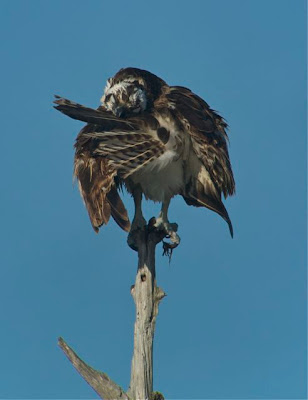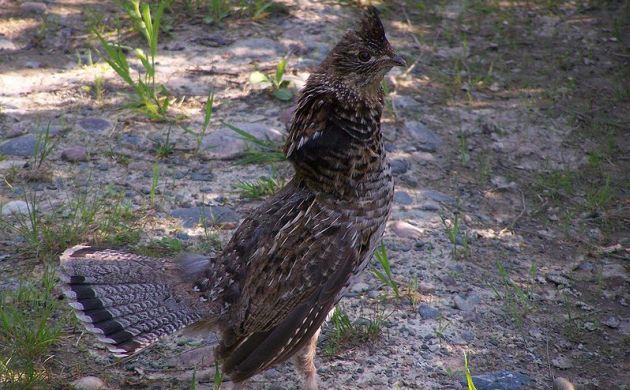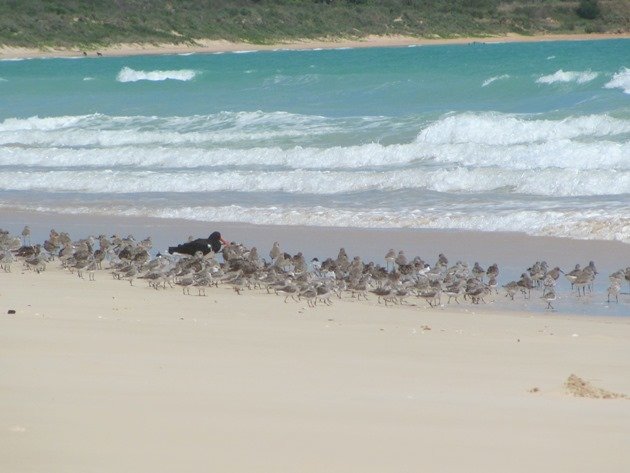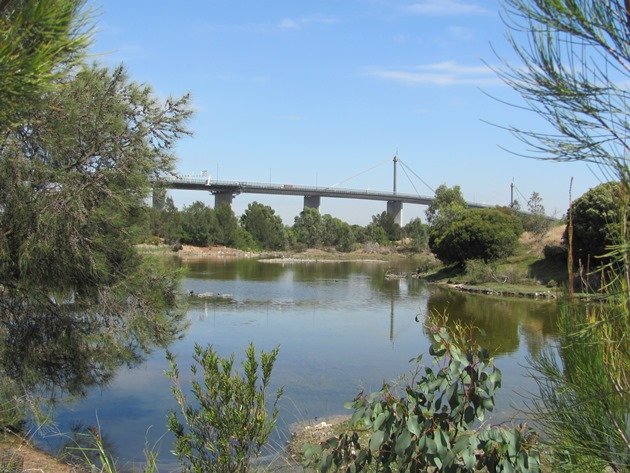Birding at Viera Wetlands near Titusville, Florida, while speaking at the Space Coast Birding and Wildlife Festival in January. My old friend, the osprey, took five to preen atop a snag. I quickly set up my Leica scope and camera to capture a few shots.
I was bemused by a photographer with a very long lens who walked up while I was digiscoping the bird. Just to make conversation, I mentioned its advanced state of molt. He made a flat retort. “Immature bird. Yep, immature bird.” I turned back to my scope and searched quietly for evidence of such in its tatty plumage, but came up empty. The wing feathers were so worn that the pale fringes that might have indicated immaturity were long gone. You can see the fresh blackbrown back feathers and scapulars coming in, but that’s all fresh adult plumage. The osprey was preening for all it was worth, trying to make itself look and feel more presentable. It had a couple of lovely new dark deck feathers on its tail, but the rest were hash, good only for falling out and being replaced–soon.
Meanwhile, the photographer, who I may have mentioned had a very big lens, pontificated to me about the bird’s youth. I started to say something about how the molting schedule of male and female ospreys was different; the females molt while incubating, and the male feeds them through this difficult time, but he kept interrupting me, so I smiled and nodded.
I couldn’t even sex this bird without seeing its breast. It looks like an older female to me in the face, but that’s pretty subtle stuff. Males tend to look goggle-eyed; females look squintier and smaller-eyed, but I’ve garnered that from having drawn them and compared notes with Alan Poole, author of the excellent book Ospreys: A Natural and Unnatural History. To sex the bird, it would have to turn around so I could see if it was wearing the dark brown chest markings we jokingly refer to as a “bra,” because only female ospreys wear them. Unless, of course, it happens to be a male with dark chest markings, and that happens, too.
The eye of an immature osprey may retain its dark orange coloration until October, after which it steadily lightens to yellow. No help there; this was January. The crown of an immature osprey tends to be more heavily streaked with brown than that of an adult. Again, unless it’s an adult with a streaky crown.
All these things ran through my mind as I tried to reconcile the photographer’s proclamation that this bird was immature with the lack of evidence at hand. He apparently took my silence for inexperience, and was proud to impart but not augment his knowledge, so I stayed my course of smiling and being pleasant about it. I wasn’t at all sure this was an immature bird, but he was, and good for him. It didn’t matter anyway. It was a nice osprey, and it was preening right here where we could both immortalize it. In bird identification disputes, I always come back to the central question: Does the fate of the world hang on this bird’s correct ID?
While we were chatting, a big flock of migrating tree swallows lifted up from the wax myrtle shrubs, gathered in a big cloud, and coursed back and forth around the preening osprey. “These swifts!” the photographer exclaimed. “They’re so fast, I can’t get a picture of them!”
I had to turn my head all the way around and bite my cheek to hide my grin. One of the best things I learned at Harvard was as an outspoken freshman at my first afternoon sherry gathering. Someone said to me, “No matter how much you may think you know about a subject, there is probably someone standing right behind you who knows a LOT more.” Amen to that, and thank you, guardian angel, for clobbering me with it as a freshman. And so those who know how old this osprey might be, photographed January 28, 2011 at Viera Wetlands in Florida, step right up. Heck. I’d love to think Big Lens may be right after all.
Images taken with a Leica digiscoping rig, described here.









 New writers welcome – please contact us for details.
New writers welcome – please contact us for details.

















I can’t help but add a few thoughts to your description of this encounter and Big Lens’ style of Birding ID. His “flat retort” is what I, as a novice can take little from. Thankfully, I imagine he’s not leading a group of others in the field.
Your ability to dissect the telling features: eyes, breast, scapulars,… is often what is never spoken of. A quick and passing ID allows the tick off the list, but leaves a novice only with the impression that messy bird = immature bird. Unless it’s pulled apart and laid out on the table, I won’t ‘get it.’ And next time, I’ll still look aimlessly at this bird.
What sets guides apart is more than their ability to identify and get me on the bird. I need them to spill their brain, tell me what it’s not and why–let me hear the wheels turning. I’ll be a better birder for it.
Until then, I stick close to those who will teach me.
Okay, I am not pretending to have any confidence in what I am about to write, but the secondaries seem to show a rather prominent and regular barring above, and that might be indicative of an … immature bird.
No, no! I didn’t write that. I kept my mouth shut and fingers off the keyboard. 🙂
Bein’ as how I was standing behind the gentleman when he enlightened you, I have to say that you handled it nicely. I would not have been nearly so polite — which is why people love you and think me a crusty old curmudgeon. (I wonder if he may have read this and found out who he’d been enlightening?)
I have to say, though, that if that bird was a juvenile, it had already had an extremely rough life. Those feathers weren’t in real good shape.
OMG! The sky is falling!